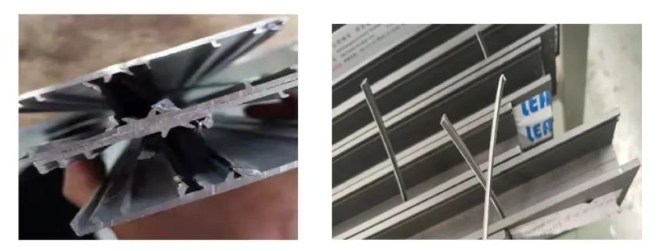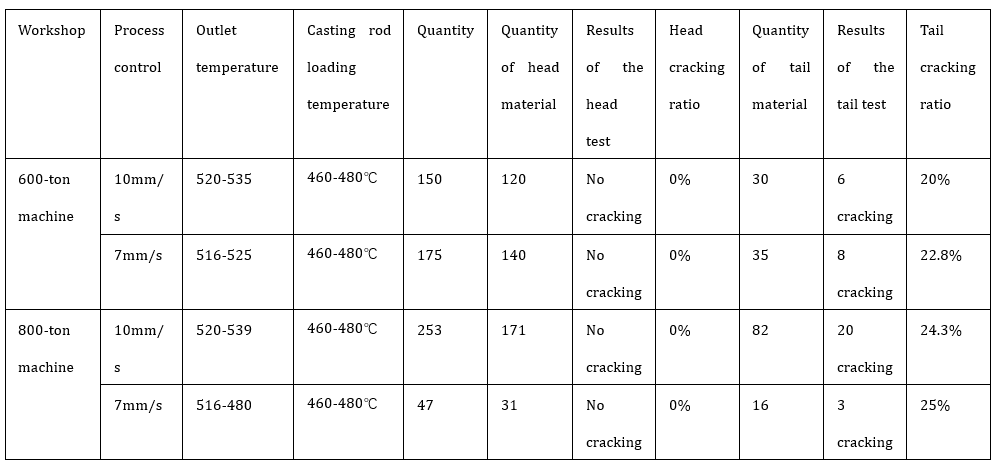1 Overview
The production process of thermal insulation threading profile is relatively complex, and the threading and laminating process is relatively late. The semi-finished products flowing into this process are completed through the hard work of many front-process employees. Once waste products appear in the composite striping process, they will If it causes relatively serious economic losses, it will lead to the loss of a lot of previous labor results, resulting in huge waste.
During the production of thermal insulation threading profiles, profiles are often scrapped due to various factors. The main cause of scrap in this process is the cracking of the heat-insulating strip notches. There are many reasons for the cracking of the heat-insulating strip notch, here we mainly focus on the process of finding the reasons for the defects such as shrink tail and stratification caused by the extrusion process, which lead to the cracking of the notches of the aluminum alloy heat insulation profiles during the threading and laminating, and solve this problem by improving the mold and other methods.
2 Problem phenomena
During the composite production process of heat insulation threading profiles, batch cracking of heat-insulating notches suddenly appeared. After checking, the cracking phenomenon has a certain pattern. It all cracks at the end of a certain model, and the crack lengths are all the same. It is within a certain range (20-40cm from the end), and it will return to normal after a period of cracking. The pictures after cracking are shown in Figure 1 and Figure 2.
3 Problem finding
1) First, classify the problematic profiles and store them together, check the cracking phenomenon one by one, and find out the commonalities and differences in cracking. After repeated tracking, the phenomenon of cracking has a certain pattern. It all cracks at the end of a single model. The shape of the cracked model is a common piece of material without a cavity, and the cracking length is within a certain range. Within (20-40cm from the end), it will return to normal after cracking for a while.
2) From the production tracking card of this batch of profiles, we can find out the mold number used in the production of this type, during production, the geometric size of the notch of this model is tested, and the geometric size of the heat insulation strip, the mechanical properties of the profile and the surface hardness are all within a reasonable range.
3) During the composite production process, the composite process parameters and production operations were tracked. There were no abnormalities, but there were still cracks when the batch of profiles was produced.
4) After checking the fracture at the crack, some discontinuous structures were found. Considering that the cause of this phenomenon should be caused by extrusion defects caused by the extrusion process.
5) From the above phenomenon, it can be seen that the cause of the cracking is not the hardness of the profile and the composite process, but is initially determined to be caused by extrusion defects. In order to further verify the cause of the problem, the following tests were performed.
6) Use the same set of molds to conduct tests on different tonnage machines with different extrusion speeds. Use a 600-ton machine and an 800-ton machine to conduct the test respectively. Mark the material head and material tail separately and pack them into baskets. The hardness after aging at 10-12HW. The alkaline water corrosion method was used to test the profile at the head and tail of the material. It was found that the material tail had shrink tail and stratification phenomena. The cause of the cracking was determined to be caused by shrink tail and stratification. The pictures after alkali etching are shown in Figures 2 and 3. Composite tests were conducted on this batch of profiles to check the cracking phenomenon. The test data are shown in Table 1.
Figures 2 and 3
7) From the data in the above table, it can be seen that there is no cracking at the head of the material, and the proportion of cracking at the tail of the material is the largest. The cause of cracking has little to do with the size of the machine and the speed of the machine. The cracking ratio of the tail material is the largest, which is directly related to the sawing length of the tail material. After the cracking part is soaked in alkaline water and tested, shrink tail and stratification will appear. Once the shrink tail and stratification parts are cut off, there will be no cracking.
4 Problem solving methods and preventive measures
1) In order to reduce notch cracking caused by this reason, improve yield, and reduce waste, the following measures are taken for production control. This solution is suitable for other similar models similar to this model where the extrusion die is a flat die. The shrink tail and stratification phenomena produced during extrusion production will cause quality problems such as cracking of the end notches during compounding.
2) When accepting the mold, strictly control the notch size; use a single piece of material to make an integral mold, add double welding chambers to the mold, or open a false split mold to reduce the quality impact of shrink tail and stratification on the finished product.
3) During extrusion production, the surface of the aluminum rod must be clean and free of dust, oil and other contamination. The extrusion process should adopt a gradually attenuated extrusion mode. This can slow down the discharge speed at the end of the extrusion and reduce shrink tail and stratification.
4) Low temperature and high speed extrusion are used during extrusion production, and the temperature of the aluminum rod on the machine is controlled between 460-480℃. The mold temperature is controlled at 470 ℃ ± 10 ℃, the extrusion barrel temperature is controlled at about 420 ℃, and the extrusion outlet temperature is controlled between 490-525 ℃. After extrusion, the fan is turned on for cooling. The residual length should be increased by more than 5mm than usual.
5) When producing this type of profile, it is best to use a larger machine to increase the extrusion force, improve the degree of metal fusion, and ensure the density of the material.
6) During extrusion production, an alkali water bucket must be prepared in advance. The operator will saw off the tail of the material to check the length of the shrink tail and stratification. Black stripes on the alkali-etched surface indicate that shrink tail and stratification have occurred. After further sawing, Until the cross-section is bright and has no black stripes, check 3-5 aluminum rods to see the length changes after shrink tail and stratification. In order to avoid shrink tail and stratification from being brought to the profile products, 20cm is added according to the longest one, determine the sawing length of the tail of the mold set, saw off the problematic part and start sawing into the finished product. During the operation, the head and tail of the material can be staggered and sawed flexibly, but defects must not be brought to the profile product. Supervised and inspected by machine quality inspection. If the length of the shrink tail and stratification affects the yield, remove the mold in time and trim the mold until it is normal before normal production can begin.
5 Summary
1) Several batches of heat-insulating strip profiles produced using the above methods were tested and no similar notch cracking occurred. The shear characteristic values of the profiles all reached the national standard GB/T5237.6-2017 requirements “Aluminum Alloy Building Profiles No. 6 Part: for Insulating Profiles”.
2) In order to prevent the occurrence of this problem, a daily inspection system has been developed to deal with the problem in time and make corrections to prevent the dangerous profiles from flowing into the composite process and reduce the waste in the production process.
3) In addition to avoiding cracking caused by extrusion defects, shrink tail and stratification, we should always pay attention to the cracking phenomenon caused by factors such as the geometry of the notch, the surface hardness and mechanical properties of the material and the process parameters of the composite process.
Edited by May Jiang from MAT Aluminum
Post time: Jun-22-2024



